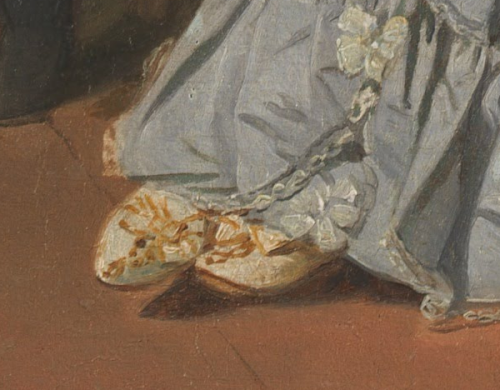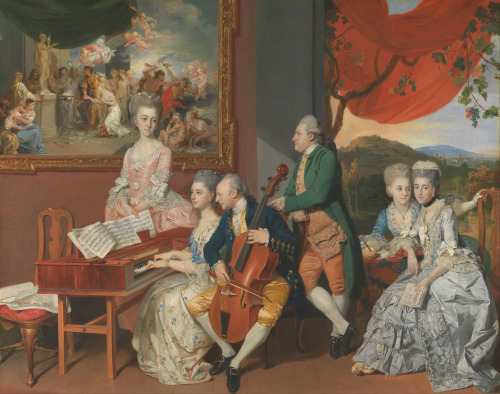Unfortunately there are so few surviving examples of shoes compared to what there truly was and most portraits don't show the feet clearly. But, every once in a while, there's enough of a trend visible that even we can notice it today. Take for example this particular style of ladies shoes. There are numerous surviving examples, some even are dated because of weddings, and at least a couple of portraits! I'm hoping to continue finding dated extants and imagery of this style so the others can be given much more specific dating than the decade or two cushion usually afforded.
The consistencies I noticed were not only the bouquet embroidery on the toe, but both figured silk and contrasting straps/heels seemed very popular around this time as well. While those by themselves are posts for another day, they do tie in this style to a more specific time period.
You'll notice that the two portraits and the pair that mentions being from a wedding are 1775, 1776, and 1777. Some are dated later, and perhaps could be remnants of a popular style, but I believe that the concrete dating could provide major evidence to move that estimated date slightly earlier. Also, notice the major discrepancies in dates of similar styles from the same museum. I'm still looking for more extants and more portraits, but at the moment I'd feel safe putting any of these as 1775-81. Honestly, if going by heel and toe shape, if that dating does hold correct, these might even be brought down to a two or three year range.
I'm definitely disagreeing with that date.


Johan Joseph Zoffany, The Gore Family, 1775
Interestingly enough (and muddying the easy dating) the embroidery on the toe of the vamp continues through the 1780s and perhaps is part of what starts the 1790s trend for the cut-out work on the toe in leather. I can't say with consistency yet, but both of these pairs have a much more laddered style of embroidery compared to the bouquets of the 1770s. Perhaps changing with the toe shape? Or perhaps this particular pattern change is mirrored in fabric as well?



I'm very curious how much these shoes were uncomfortable.
ReplyDeleteThese high heels, like in second pair, look really unhealthy for feets.
Beautiful embroidery. That picture of the Copley family was lovely. The painter really captures the children in such a precious way.
ReplyDeleteIt is very interesting to read about. Like Magrat, I can't help but think these shoes look uncomfortable, the angle looks like one that would be very uncomfortable to me, then again, I am someone who prefers flat shoes!
ReplyDeleteI love your theory! I had never noticed the embroidery trend on museum shoes, but I am compelled to agree with you after looking at all the beautiful shoes you presented as evidence! I agree that the black Russian shoe is much later than it is currently dated. Come to think of it, the preferred method of decoration before 1760 was a strip of metallic ribbon sewn the length of the vamp (and generally thicker heels). Perhaps embroidery started based on this trend and morphed into beautiful bouquets by the 1770s.
ReplyDeleteWonderful post. I've looked at that Copley group portrait a zillion times, and somehow NEVER noticed the toe of the shoe. This is one of my favorite era for women's shoes. To my eye, they're the perfect proportion of heel, arch, and decoration. They also look comfortable to me, especially compared to many modern shoes with much higher & narrower heels.
ReplyDelete